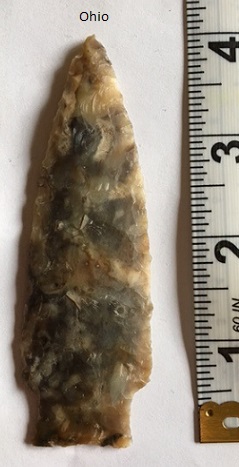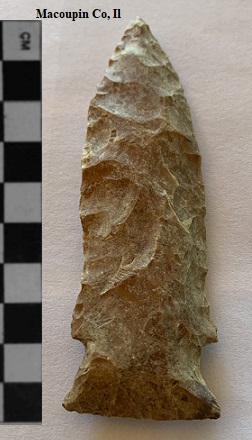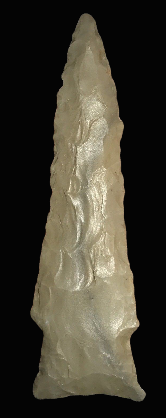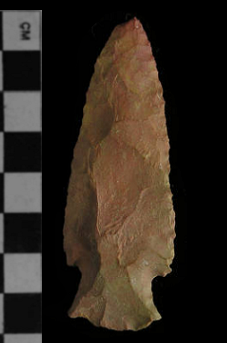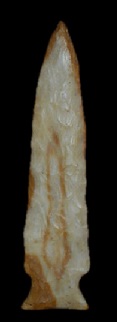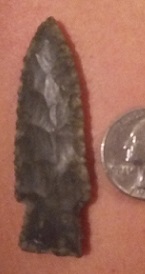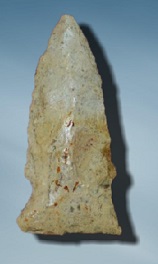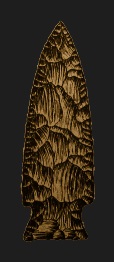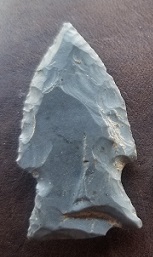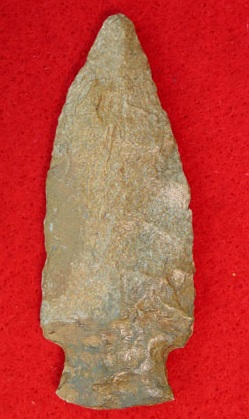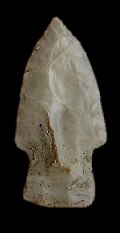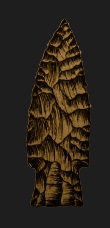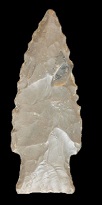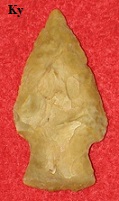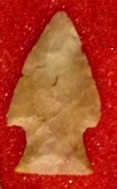Outline is Representative of Size and Shape:


Name Details:
Identified By: Howard D Winters
Named For:
Date Identified: 1963
Type Site: Multiple sites in the lower Wabash Valley, Illinois
Identified By: Howard D Winters
Named For:
Date Identified: 1963
Type Site: Multiple sites in the lower Wabash Valley, Illinois
Point Validity:
Valid type
Winters is a distinguished anthropologist who did extensive research in Illinois. He identified this point during the survey of the Wabash Valley in Illinois. This point was named in a professional publication and has many professional references. This is a valid type.
Lowe Flared Base
Cluster: Lowe / Steuben Cluster Description of Physical Characteristics and Flaking Pattern:
This is a medium expanding stem point with an elliptical cross section. The blade ranges from excurvate to straight. Shoulders may range from slightly barbed to having an upward angle. The blade is commonly beveled. The stem is expanding with the sides of the stem being straight. Beveling is commonly seen on all edges of the stem and base, grinding may be present. The base may be straight to slightly convex base. This point has a random flaking pattern.
Size Measurements:
Total Length - 36 to 110 mm, Stem Length - 10 to 17 mm, Blade Width - 17 to 33 mm (average 22 mm), Neck Width - 13 to 22 mm, Stem Width - 16 to 33 mm, Thickness - 4 to 9 mm
Total Length - 36 to 110 mm, Stem Length - 10 to 17 mm, Blade Width - 17 to 33 mm (average 22 mm), Neck Width - 13 to 22 mm, Stem Width - 16 to 33 mm, Thickness - 4 to 9 mm
Commonly Utilized Material:
Blue and gray cherts
Blue and gray cherts
Additional Comments:
This cluster was used in the middle to late Woodland period. These points replaced the large corner notch points (Snyders), and were replaced by Jacks Reef, Intrusive Mound, Knight Island, and Raccoon Creek points (Justice 1987).
Stephens (1975) points out that one of the key characteristic differences between the Allison and the Lowe is the angle of the blade. A line drawn along the stem edges would interest at the tip for the Lowe type and would interest at the center of the blade for the Allison type:


This cluster was used in the middle to late Woodland period. These points replaced the large corner notch points (Snyders), and were replaced by Jacks Reef, Intrusive Mound, Knight Island, and Raccoon Creek points (Justice 1987).
Stephens (1975) points out that one of the key characteristic differences between the Allison and the Lowe is the angle of the blade. A line drawn along the stem edges would interest at the tip for the Lowe type and would interest at the center of the blade for the Allison type:


Distribution:

Distribution Comments:
This point is is most common in the lower Wabash valley and lower Ohio River valley (Southern Illinois, southern Indiana, western Kentucky and western Tennessee).
This point is is most common in the lower Wabash valley and lower Ohio River valley (Southern Illinois, southern Indiana, western Kentucky and western Tennessee).
Age / Periods:
Date: 1,800 - 1,400 B.P.
Cultural Period: Woodland
Glacial Period: Roman Warm
Culture: LeMotte Culture
Phase:
Date: 1,800 - 1,400 B.P.
Cultural Period: Woodland
Glacial Period: Roman Warm
Culture: LeMotte Culture
Phase:
Age Details:
This point is part of the Allison Complex
This point is part of the Allison Complex

